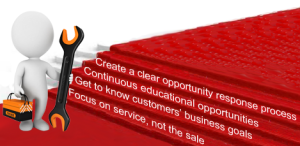 The fourth step in creating a Proactive Service® culture for your field service team is to ensure that there is a clear and consistent process for handling opportunities from the field. Without a clear process, we leave the follow-up largely to chance and create the potential for frustration and resentment on the part of our technicians and customers.
The fourth step in creating a Proactive Service® culture for your field service team is to ensure that there is a clear and consistent process for handling opportunities from the field. Without a clear process, we leave the follow-up largely to chance and create the potential for frustration and resentment on the part of our technicians and customers.
Nothing will stop a technician from making recommendations to a customer more quickly than poor or inconsistent follow-up by the rest of the company’s staff. A technician that makes a recommendation that requires follow-up by others (salesperson or manager for example) and which is not followed up, is unlikely to continue to do so. But worse than that, lack of follow-up can have serious consequences.
I worked with one service firm that did not have a formal process for handling opportunities from the field. I interviewed one of their technicians and he related a story that highlights the problems that can occur. The technician had found a problem with a key piece of equipment and recommended to the customer that it be replaced as soon as possible. The customer asked the technician to have someone get in touch with him with pricing and installation information for the replacement. The technician reported the opportunity on the work order along with the request for a follow-up call by the salesperson responsible for the account. Unknown to the service tech, the information did not get to the salesperson and no one followed up. About a month later, the customer called in a panic because the equipment failed, just as foretold. Rather than praising the technician for his ability to predict the failure, the customer was furious that there was no follow-up on the part of the firm. The service technician took the brunt of the customer’s anger and felt let down by his colleagues. Needless to say, by the time we spoke to the technician, he was reluctant to identify opportunities in the future.
Even when a process for opportunity management is in place, it may not include an important step. One of the most common complaints we hear from technicians is that, even when there is follow-up, the technician is not kept in the loop. The lack of a communication loop to keep the technician informed causes more than hard feelings. It also can cause a customer service failure. Let’s assume that the technician has spoken to the customer and they are interested in pursuing an idea that she brought forward that may reduce energy consumption. The salesperson or manager is duly informed and goes out to visit the customer. If there is no communication back to the technician, the salesperson may develop a solution that is beyond what the technician had in mind and far exceeds the customer’s expectations. A simple discussion with the technician would have prevented this from happening and the technician would have an opportunity to share her ideas with the salesperson that could be incorporated into the ultimate solution. In addition, by keeping the technician in the loop, the technician will have an informed response if the customer asks about the progress on the opportunity development the next time she is in their facility.
A key step therefore, to ensure that you create a successful and lasting Proactive Service® culture is to ensure that you have a clear, concise and consistent process for identifying and following-up on recommendations from the field. Not only will this improve your service delivery, but it will let your technicians (and customers) know that these recommendations are important and that they play a key role in your firm’s the overall service delivery.
I’d love your feedback! And as always, please feel free to leave a link back to your own blog if you have one via the commentluv feature here on the site. If you are reading this blog post via email, you will need to locate this post on my website by clicking here. Scroll down to the bottom of the page where you will find the comment section.
Jim
“Efficiency is doing things right; effectiveness is doing the right things.”
– Peter Drucker
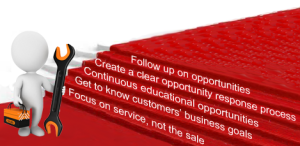 The 5th step in creating a Proactive Service® culture within your service team is to follow-up on opportunities. Following up on opportunities may seem like a self-evident step, but it is often not accomplished.
The 5th step in creating a Proactive Service® culture within your service team is to follow-up on opportunities. Following up on opportunities may seem like a self-evident step, but it is often not accomplished.
 The fourth step in creating a Proactive Service® culture for your field service team is to ensure that there is a clear and consistent process for handling opportunities from the field. Without a clear process, we leave the follow-up largely to chance and create the potential for frustration and resentment on the part of our technicians and customers.
The fourth step in creating a Proactive Service® culture for your field service team is to ensure that there is a clear and consistent process for handling opportunities from the field. Without a clear process, we leave the follow-up largely to chance and create the potential for frustration and resentment on the part of our technicians and customers.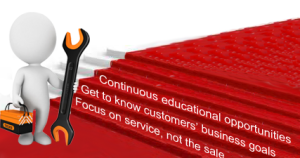 In the
In the 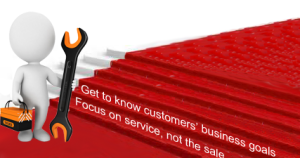 In the
In the 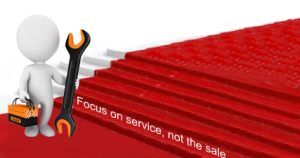 If you are interested in creating a proactive service® focus for your field service technicians, the first step is to focus on the service, not the sale. This is more than just semantics, it is a mindset that deals with the very heart of what we want our technicians to do.
If you are interested in creating a proactive service® focus for your field service technicians, the first step is to focus on the service, not the sale. This is more than just semantics, it is a mindset that deals with the very heart of what we want our technicians to do. Creating a Proactive Service® culture throughout your service team is one of the most effective ways that a service company can grow their business and create a distinctive competitive advantage. By Proactive Service®, we mean a technical service team that is engaged not only in maintaining and fixing equipment to the highest levels, but in actively looking for ways that their firms can help their customer meet their own business goals. It is proactive because the technician takes the initiative to identify opportunities to help and proactively addresses these with the customer.
Creating a Proactive Service® culture throughout your service team is one of the most effective ways that a service company can grow their business and create a distinctive competitive advantage. By Proactive Service®, we mean a technical service team that is engaged not only in maintaining and fixing equipment to the highest levels, but in actively looking for ways that their firms can help their customer meet their own business goals. It is proactive because the technician takes the initiative to identify opportunities to help and proactively addresses these with the customer.  Think that your employees are empowered to deliver an exceptional customer experience? Don’t bank on it. Your policies may be letting you down. I learned this lesson recently during a trip to a bank. It was a Saturday afternoon and I was off to the UK on business on an early morning flight on Monday. To my dismay, I realized that I did not have any British currency. No problem, I reasoned, I just need to go to the bank.
Think that your employees are empowered to deliver an exceptional customer experience? Don’t bank on it. Your policies may be letting you down. I learned this lesson recently during a trip to a bank. It was a Saturday afternoon and I was off to the UK on business on an early morning flight on Monday. To my dismay, I realized that I did not have any British currency. No problem, I reasoned, I just need to go to the bank.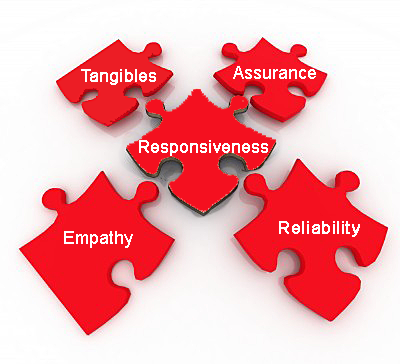 In this blog, we will consider what we can do to transform the service experience by demonstrating our responsiveness. Responsiveness shows our competence and this creates
In this blog, we will consider what we can do to transform the service experience by demonstrating our responsiveness. Responsiveness shows our competence and this creates  In my
In my 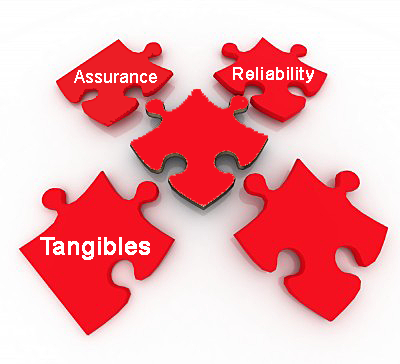 In my previous blog in this series, we discussed how to
In my previous blog in this series, we discussed how to 

